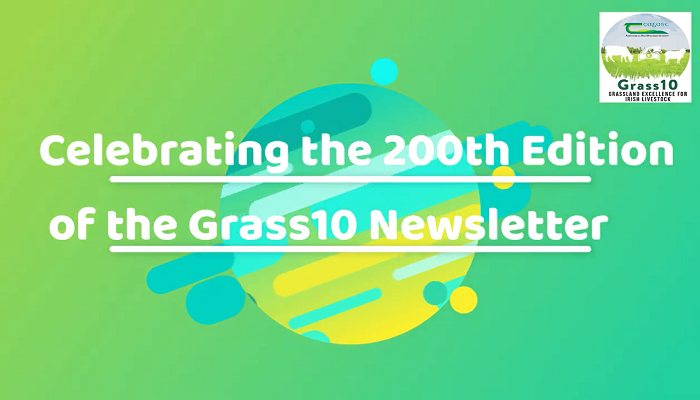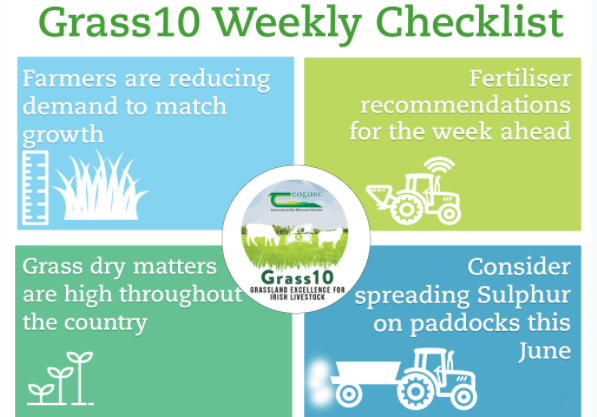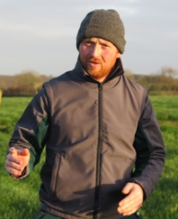22 June 2022
Grass10 Newsletter – 21st June 2022

A week ago marked the 200th Edition of the Grass10 newsletter. The Grass10 newsletter has evolved significantly since the 1st edition and there is nothing else like it for farmers involved in grassland management. The Grass10 team look at the 2022 Grass Growth Curve to date, and more this week
201st Edition – 21st June 2022

Last Tuesday, 14th June marked the 200th Edition of the Grass10 newsletter. The Grass10 newsletter has evolved significantly since the 1st edition in 2018 & there is nothing else like it for farmers involved in grassland management, which is the cornerstone for profitable livestock systems in Ireland. On behalf of the Grass10 team we would like to thank you for your continued readership of our newsletter. Watch the video to see how the Grass10 Newsletter is helping farmers achieve excellence in grazing management.






Grass10 Weekly Tips
Farmers are reducing demand to match growth
Grass growth is slightly ahead of demand on both dairy and drystock farms on average across the country. Demand has decreased on farms in line with grass growth through lower stocking rate and higher supplementation. This is the right thing to do as soil moisture deficits increase and growth continues to slow. Remember keep AFC > 550 KgDM/ha and hold a 20-25 day rotation, and don’t let pregrazing yield go below 1,100 KgDM/ha. Letting AFC go below this will exacerbate the problem. Continue to walk the farm and match demand to the growth, i.e. growth 40 KgDM/ha per day with stocking rate 3.5 LU/ha means 11.5 KgDM grass can be fed per LU (40/3.5= 11.5), total intake will be around 18 KgDM/LU. Look at making more ground available for grazing or increasing supplement to reduce demand and fill the deficit. If you are allocating silage to fill the deficit – you need to allocate grass to ensure demand is being reduced, e.g. if a paddock usually does 3 grazings, use a stripwire to make it last 4 grazings and fill the gap with silage.
Fertiliser recommendations for the week ahead
Rainfall to date is well behind at all Teagasc Research Centres ranging from 90-137mm (average 4.5 inches) behind longterm average. Apply parlour washings and watery slurry to paddocks to empty tanks. This will apply some N, P and K and is slightly more effective than chemical fertiliser in the current conditions (observations from 2018). Opportunity may arise this weekend to apply the normal rate 15-20u N/ac with some rain forecast. Some additional nitrogen will be released from the soil when rain arrives. Keep a close eye on the weather forecast towards the weekend
Grass dry matters are high across the country
The drying conditions and lack of rainfall in most southern areas has caused a big increase in dry matter in the past week. Be careful not to underestimate covers on paddocks. An increase from 16% DM to 20% DM is 25% more grass in a paddock. So a cover (based on 16% DM) estimated at 1,100 would actually have nearly 1,400 KgDM/ha, and 10 days ahead could really be 12 days ahead. Grass utilisation should be high at over 90% as grazing conditions are excellent. Do not increase supplement and leave grass behind in paddocks, it defeats the purpose. Allocate grass using the grazing calculator on PBI to help control this.
Consider spreading Sulphur on paddocks this June
Sulphur is important to improve nitrogen use efficiency and therefore, growing more grass. During dry weather sulphur availability to the grass plant becomes even more important. While most farms have some Sulphur applied (from slurry and fertiliser), from communication with farmers the amount applied is lower on some farms and a lower number have little applied. Farmers should ideally apply a high-sulphur based fertiliser to paddocks when rain is forecast.
Grass10 Featured Farmer
 Daniel Rundle, Co. Louth
Daniel Rundle, Co. Louth
Daniel farms alongside his uncle PJ near Ardee in Co. Louth. They are milking 120 cows on a challenging farm with 40% of the farm situated on the side of a steep hill. Click below to read his profile.


 Trevor Boland, Co. Sligo
Trevor Boland, Co. Sligo
This section will give weekly reports and videos from farmers who have a lot of clover established on their farms.
This week, beef farmer Trevor Boland give us an update of how he is managing his grass-clover swards for sward and animal performance

The Beef Edge Podcast
Tune in to this week’s Beef Edge podcast as Teagasc Beef specialist Aidan Murray outlines the fodder support scheme and John Maher, Grass10 Manager discusses top tips to deal with the current grass situation on farms and the BEEF2022 open day 5th July in Teagasc Grange.
Launch of 2021 GFOY Winner Farm Walks
Sean O’Donnell and his family farm just outside Ballina, Co. Mayo milking 215 crossbred cows across two milking platforms. The O’Donnell’s were the “Mixed Soils” category winners of the 2021 Grassland Farmer of the Year Competition. Join us on Friday, 8th July at 11am for a farm walk on the O’Donnell’s home farm near Ballina, Co. Mayo, F26 WP86. The event will focus on farm overview and herd performance, grassland management, incorporating & managing grass–clover swards, and there will be drainage demonstration on the day!
Sign up for weekly grass 10 newsletter



